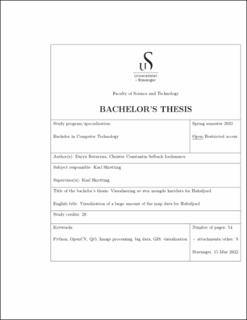| dc.contributor.advisor | Skretting, Karl | |
| dc.contributor.author | Iordanescu, Christer | |
| dc.contributor.author | Baturyna, Darya | |
| dc.date.accessioned | 2022-07-16T15:51:23Z | |
| dc.date.available | 2022-07-16T15:51:23Z | |
| dc.date.issued | 2022 | |
| dc.identifier | no.uis:inspera:93568650:44540233 | |
| dc.identifier.uri | https://hdl.handle.net/11250/3006036 | |
| dc.description.abstract | The problem statement is to create an application that can process large and redundant data files received as coordinates of Hafrsfjord along with depth level, such that depth for each point can be shown expediently; with further data visualization as images and depth simulation to show drying of the whole Hafrsfjord as well as the part of it.
The workload is split into two parts: one for the handling of the raw data, and one for the visualization. The raw data files containing the coordinates with their respective depth levels were processes so that they could be stored in two-dimensional data structures. This was done in order for the data structures to be converted into images. Instead of converting the depth coordinates into a single big image, the decision was made to create the image through splitting it into tiles. Received images in the form of tiles of specified size are displayed in the application. All loading is happening in the background to avoid lags due to the amount of images. To show drying of the Hafrsfjord, a depth simulator is created, allowing to change the water level based on the chosen sea level.
The solution to the problem was to generate data structures for each tile, so that when reading through the data files, each coordinate could be appended to its belonging data structure. This resulted in each data structure could easily be converted into a tiled image. The final application includes an easy-to-use user interface, that automatically arranges multiple photos with thought to effectivity, provides depth level and drying features and includes a built-in map editor e.g., grid, pointer, extra map signs, etc. | |
| dc.description.abstract | The problem statement is to create an application that can process large and redundant data files received as coordinates of Hafrsfjord along with depth level, such that depth for each point can be shown expediently; with further data visualization as images and depth simulation to show drying of the whole Hafrsfjord as well as the part of it.
The workload is split into two parts: one for the handling of the raw data, and one for the visualization. The raw data files containing the coordinates with their respective depth levels were processes so that they could be stored in two-dimensional data structures. This was done in order for the data structures to be converted into images. Instead of converting the depth coordinates into a single big image, the decision was made to create the image through splitting it into tiles. Received images in the form of tiles of specified size are displayed in the application. All loading is happening in the background to avoid lags due to the amount of images. To show drying of the Hafrsfjord, a depth simulator is created, allowing to change the water level based on the chosen sea level.
The solution to the problem was to generate data structures for each tile, so that when reading through the data files, each coordinate could be appended to its belonging data structure. This resulted in each data structure could easily be converted into a tiled image. The final application includes an easy-to-use user interface, that automatically arranges multiple photos with thought to effectivity, provides depth level and drying features and includes a built-in map editor e.g., grid, pointer, extra map signs, etc. | |
| dc.language | eng | |
| dc.publisher | uis | |
| dc.title | Visualisering av stor mengde kartdata for Hafrsfjord | |
| dc.type | Bachelor thesis | |
